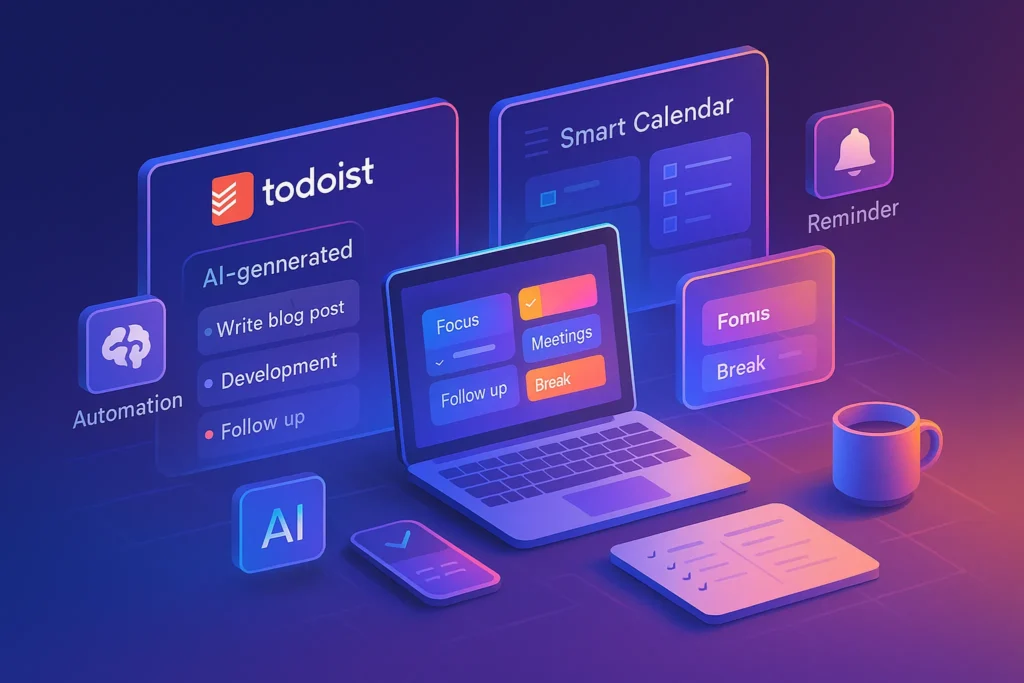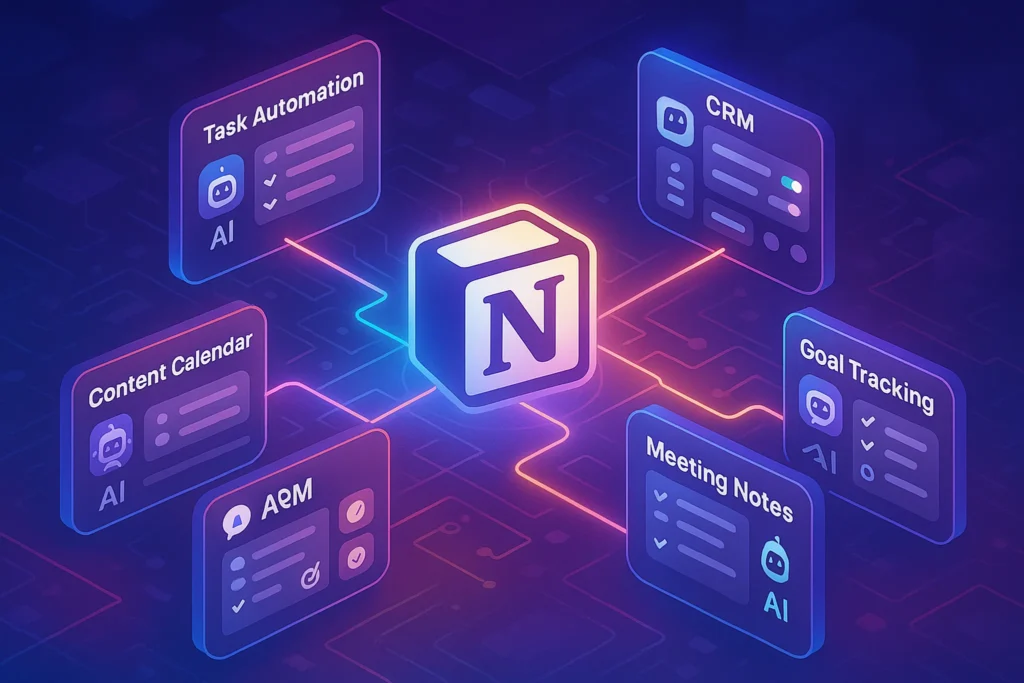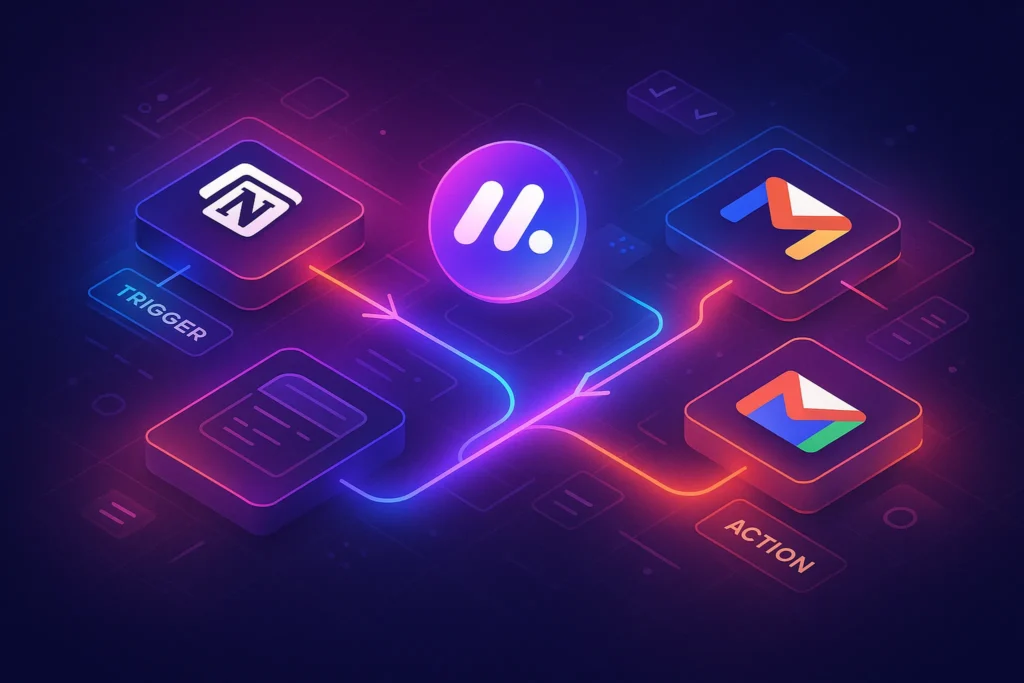-This post may contain affiliate links. If you click on one and make a purchase, I may earn a small commission at no extra cost to you.-
🧭 Introduction
Imagine a world in which your planner doesn’t just list tasks—it seamlessly organizes them into your calendar based on your unique work patterns and priorities. No more wrestling with deadlines, scheduling conflicts, or chaotic to-do lists. That world is here, powered by AI.
Today’s AI-powered productivity tools like Todoist AI, Trevor AI, Reclaim, and Motion reinterpret task and time management. They understand your goals, break down complex projects into realistic steps, and dynamically schedule them into your available time—completely hands-free. Whether you’re building off systems like Best Smart Calendar Apps for Productivity or implementing routines from Productivity System Setup, this guide will help you turn your planner into an intelligent co-pilot—so you can spend less time organizing and more time doing.
In this deep dive, we’ll cover:
-
How AI analyzes and structures your tasks
-
AI scheduling assistants that defend your deep work
-
Task capture, prioritization, and calendar syncing
-
Practical workflows for seamless integration
-
The limits of AI—and where human oversight remains essential
Let’s explore how to build a smarter, more aligned schedule—without the busywork.
🤖 What AI Adds to To‑Do & Time Management
AI is no longer a simple autocomplete tool; it’s becoming an autonomous planner embedded within your workflow.
Take Todoist AI Assistant. Once limited to reminders, it now helps break down vague tasks—like “Launch Q3 campaign”—into concrete sub-tasks such as “Draft campaign outline,” “Choose email template,” and “Define metrics”. You can ask for tips or rewrite tasks to be more actionable, smoothing the path from intention to completion.
Similarly, Trevor AI syncs with your to-do list and calendar. When you ask “Plan My Day,” the AI predicts realistic durations for tasks and suggests slots between meetings. You simply click to accept the schedule—ideal for a hands-off planning mode.
These tools transform your to-do list from static data into a dynamic daily plan—all with minimal effort.
When you think of managing tasks or your calendar, AI is no longer just a smart sorting tool—it’s becoming an active planner. Traditional digital planners shuffle tasks and reminders. AI-enabled tools go further: they suggest optimal scheduling, detect timing conflicts, break down complex tasks, and even adapt your plan as your day shifts.
For example, Todoist’s AI Assistant analyzes your goals and breaks them into actionable subtasks. It can propose an order of work or suggest missing steps to complete a project—reducing mental load and helping you start faster. Similarly, smart to-do apps like Magic ToDo use AI to automatically organize tasks by “spiciness” and adjust categories with minimal input. In essence, AI transforms your to-do list from a passive record into an intelligent productivity partner.
🗓️ AI Scheduling Assistants for Your Calendar
Managing meetings and time blocks can be a full-time job itself. AI scheduling assistants like Reclaim and Motion automate that burden, protecting your priorities and supporting your rhythms.
With Reclaim, you define “Focus Time,” tasks, habits, buffer periods, and availability—and the AI intervenes. It auto-schedules around meetings, suggests smart meeting times across teams, and prevents back-to-back overwhelm using buffer time. Reclaim even offers “Scheduling Links” so others can book around your existing priorities—without conflict.
Motion uses similar intelligence to automatically create focused work blocks each morning—sometimes reserving hours for “Creative Work,” “Admin,” or “Deep Calls”—based on your plan and current commitments.
The result? Your calendar stops managing you—AI structures it around what matters.
Gone are the days of endless back-and-forth over meeting times. AI scheduling assistants—like Reclaim, Motion, and Clockwise—automate the heavy lifting. They analyze your availability, prioritize existing tasks, protect focus blocks, and even reschedule recurring tasks to avoid overload.
Take Reclaim: it automatically safeguards your personal habits (e.g., exercise, lunch) by inserting buffer time into your calendar, and reschedules conflicting events to preserve flow . Motion uses AI to generate consistent daily blocks for work, meetings, and breaks without your manual input. Clockwise rounds things out by clearing and prioritizing time across team calendars—ensuring your day remains productive and interruption-free.
📈 AI Tools That Automate Task Input & Workflow
Beyond planning, AI can streamline task creation and execution:
-
Chatbot-to-do builders (like Zapier integrations): convert email or chat prompts into precise task entries automatically.
-
Magic ToDo analyzes plain-language entries, organizes them by priority, and generates next steps.
-
Twos offers smart recommendations and lets you search your task archive via AI-powered chatbot .
These assistants reduce friction in capturing tasks—because your workflow shouldn’t pause to translate intention into system input.
Adding and structuring tasks becomes effortless with AI-powered tools:
-
Chatbot-to-do builders: Zapier Chatbots generate to-do items based on conversation prompts—turning casual language into structured workflows.
-
Magic ToDo: It analyzes your plain-language tasks and breaks them into step-by-step actions automatically, helping you start even when you’re unsure what “next” means.
-
Twos: This minimalist app offers “smart suggestions” for your tasks—like suggesting calendar events or shopping links when you mention them in your list—and even includes an AI chatbot for finding past content.
These tools reduce the friction between intention and execution—empowering you to quickly move from idea to action without getting bogged down in platform navigation.
🔄 Workflow Integration & Real-World Setup
To take full advantage of AI-powered to-do and calendar systems:
Here’s an actionable setup to harness AI for your daily productivity:
-
**Goal Breakdown & Capture**
Use Todoist AI to turn “Prepare Q3 Report” into specific subtasks.
Connect it via Trevor AI to your calendar—so each task is placed into a realistic time slot. -
Protect & Prioritize
Integrate Reclaim or Motion with your calendar. AI creates “Focus Time” blocks, schedules habits, and allocates buffers—ensuring your TODOs aren’t interrupted. -
Natural Task Input
When new tasks arise, use Magic ToDo or default chatbots to add them—AI organizes priority and next actions automatically. -
Daily Review & Adapting
At day’s end, review your schedule and make minor adjustments. The AI learns your patterns and improves over time. -
Weekly Reflection
Compare scheduled vs. completed tasks—adjust your AI’s planning styles to match your actual productivity rhythm.
This integrated setup turns your planner into a smart system that self-adjusts and evolves with your work.
🚫 The Limits & Human Oversight
While AI offers automation, it isn’t perfect. It may misinterpret informal wording, misplace high-priority items, or make awkward calendar suggestions without human context. Treat AI as a trusted helper—not a completely autonomous manager. Always review suggestions, confirm critical events, and maintain final control over your schedule. With conscious partnership, AI works for you—not the other way around.
AI enhances productivity but can’t replace discernment:
-
Natural language is ambiguous—AI might misinterpret vague tasks (“plan event” could mean invite guests or book a venue). Clear, concise inputs help.
-
Not everything fits AI patterns. Important one-off events still require manual checking.
-
Privacy matters: grant only essential permissions and understand how your data is handled.
AI is a powerful assistant—but not yet a fully independent decision-maker.
👩💻 Real Creator Use Case: From Chaos to Clarity
Take Sarah, a freelance content creator managing clients, YouTube production, and newsletter publishing. Her old setup? A Google Doc to-do list, a cluttered calendar, and sticky notes everywhere.
After switching to a stack of Todoist AI + Reclaim + Zapier, here’s how her life changed:
-
Todoist AI breaks client deliverables into weekly chunks and sub-tasks—no more forgetting what’s due when.
-
Reclaim adds automatic “writing focus” time every weekday morning and even blocks “recharge” time between meetings.
-
Zapier connects completed tasks to a Notion dashboard, logging everything she finishes into a performance tracker.
The result? Fewer decisions. More momentum. Sarah’s output hasn’t just doubled—she says she feels like she’s finally in control of her time.
⚠️ Beginner Mistakes to Avoid
AI doesn’t solve problems magically—it enhances systems. Here are three mistakes to sidestep:
1. Over-scheduling with no buffers
New users often let AI fill every inch of their calendar. But reality needs room for chaos. Always leave flexible “white space” between blocks.
2. Mislabeling tasks with unclear language
Avoid vague entries like “Project X.” Use actionable verbs and context: “Draft intro email for X client.” AI performs better with specifics.
3. Letting AI replace weekly review
AI is great at suggesting time slots—but you’re still the strategist. If you skip your weekly review, AI might prioritize the wrong things.
Treat AI like a junior assistant: smart, but needing direction.
🚀 Quickstart: Your Setup in 5 Simple Steps
Step 1: Choose a task tool like Todoist AI or Goblin Magic ToDo
Step 2: Choose a calendar AI like Reclaim or Motion
Step 3: Connect your task manager to your calendar
Step 4: Set core availability, buffer preferences, and deep work hours
Step 5: Run a daily 5-minute review each morning to approve or tweak the AI’s plan
Once dialed in, this system runs like a productivity autopilot—with you in the pilot seat.
🔗 Bonus: Supercharge Your System with AI + Automation Stacks
While AI tools like Todoist AI and Motion optimize what you do and when you do it, there’s a whole other layer of productivity that begins after the planning stage—automation.
That’s where tools like Zapier come in. When combined with your AI stack, Zapier can auto-trigger actions based on your schedule, task completions, or emails. For example, completing a task in Todoist could automatically log it in Notion, or adding a calendar event could trigger a Slack reminder for your team.
If you want to truly eliminate repetitive admin work, check out our guide on the Top Zapier Automations Every Creator Needs. It breaks down automation recipes tailored for busy creatives and solopreneurs—and shows how to integrate them with your existing AI toolkit.
🧠 Nerd Verdict
AI transforms planning from reactive wandering into purposeful orchestration. Tools like Todoist AI, Trevor AI, Reclaim, and Motion free you from micromanagement—so your attention stays on high-impact work, not logistics. This isn’t about doing more—it’s about doing the right things in the right way, at the right time—with less friction and more flow.
❓ FAQ
Q: Do I need to pay for all these AI tools?
A: Many offer free plans—for example, Todoist AI requires a paid tier, but Reclaim and Clockwise include generous free plans. Start small and upgrade as your usage justifies it.
Q: Can AI handle recurring habits like exercise or reading?
A: Yes—Reclaim and Motion both support scheduling habits and routines automatically, often adjusting as your availability changes.
Q: How do AI tools respect privacy/security?
A: The top tools—Todoist, Reclaim, Clockwise—adhere to industry-standard encryption, OAuth permissions, and data privacy policies. Always review their compliance terms before connecting sensitive accounts.
Q: Is AI automation secure?
A: Yes—top tools like Reclaim and Todoist use standard encryption, data privacy policies, and user consent settings. Always verify each tool’s compliance before syncing sensitive data.
Q: Do these tools cost money?
A: Basic AI features are often free (e.g., Trevor AI task sync, Reclaim’s Lite plan). Premium services like Todoist AI often require paid plans (€5–8/month) .
Q: Will AI replace my planner?
A: Not fully. AI is best treated as a co-pilot. You define your goals, review schedules, and make adjustments. AI handles the grunt work—giving you freedom to focus.
💬 Would You Bite?
Which AI-powered helper will you try first—Goal breakdown with Todoist, auto-scheduling blocks with Reclaim, or natural language task input with Magic ToDo?
Drop a comment below.👇



